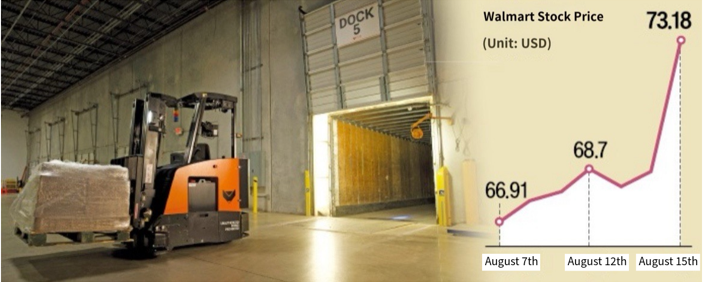
Walmart, the world’s largest retailer, which quickly introduced artificial intelligence (AI), continues its record-high stock price march due to improved productivity and strong performance. It has emerged as a prime example of subduing the “AI overinvestment theory” that has spread on Wall Street in the U.S. as AI investment in all directions, from distribution to sales, continued to lead to results. Walmart announced on the 15th (local time) that its sales rose 4.8% year-on-year to $169.34 billion in its second quarter earnings report. Operating profit rose 8.5% to $7.9 billion, and adjusted earnings per share (EPS) rose 9.8% to $0.67. Both sales and profits exceeded market expectations. The stock price rose 6.58% from the previous day to close at $73.18, a record high.
Walmart identified AI as a key driver of its future growth. At the conference call, Walmart CEO Doug McMillon said that the company improved more than 850 million pieces of marketing data by using Generative AI.
Walmart has introduced an AI-based search function that utilizes marketing data from online websites and apps. For example, when asked about the most appropriate TV for sports viewing, they select a list of related products and ask back questions such as “What is the lighting condition of the room where the TV is to be placed?” This is a way to help consumers choose the best product through interaction rather than just a simple search.
If you search for “a product necessary for a group meeting watching a soccer game”, you will get a product proposal tailored to your preferences without having to search for items such as liquor snacks one by one.
CEO McMillan explained, “Improving product description data can affect everything we do, from inventory management and order delivery.” Walmart CEO John Furner emphasized the strong productivity of AI, saying, “If we hadn’t used generative AI, we would have needed about 100 times the current manpower to complete the work.” Walmart has actively introduced automatic forklifts and AI automatic payment systems with AI functions over the years. Investment in artificial intelligence (AI) is gradually leading to tangible results such as productivity improvement in the corporate field. Some predict that more than 40% of major U.S. listed companies will improve their performance thanks to the use of AI by next year. Some raise concerns about overinvestment, but many predict that in the long run, only companies that win the “AI war” will survive. Walmart announced second-quarter earnings and forecasts that exceeded market expectations on the 15th (local time), saying AI led to productivity improvement. This is thanks to the wide introduction of AI from logistics to office work to reduce labor costs and improve productivity. Investment in AI automation reduces advertising costs, food waste and theft risks, and saves billions of dollars by introducing autonomous driving technology.

Walmart’s AI success equation is “entrance-wide transformation.” It applied AI to its overall work system, not just limited to some tasks. In April, Walmart decided to introduce 19 robot forklifts from Fox Robotics, a maker of self-driving forklifts, to four distribution centers. Instead of running the forklifts themselves, workers shifted to supervising them. In the second half of last year, it introduced “My Assistant,” a Generative AI function, into its internal work system. About 75,000 employees in 11 countries increased productivity by using in-house customized AI programs.
There are no exceptions to traditionally large-scale human decision-making processes, such as negotiating with suppliers. This is the fourth year that Walmart has introduced a chatbot for the negotiation process. Walmart has automated negotiations with about 100,000 suppliers with its chatbot developed with “Factom,” an AI-based enterprise transaction automation platform company, since 2020. When Walmart enters the desired product, budget, and negotiation target into the chatbot, the chatbot is in charge of the process of finding the right supplier based on past transaction details and proposing price and quantity. Negotiation time, which used to take weeks to months, has been shortened to several days, and 2,000 negotiations can be conducted simultaneously. The satisfaction level of suppliers reaches 75 percent.
Walmart, which pays more than half of its sales from groceries, also plans to introduce AI to supply chain management to greatly increase the efficiency of logistics management. Walmart introduced a data-based information technology (IT) agricultural solution in June by joining hands with Agritask, a food supply chain software company, to stabilize crop supply and minimize food waste. It collects data on crop growth in agricultural land remotely, and then uses AI’s machine learning and analysis functions to analyze the expected yield of crops, identify alternative crop sources, and when to purchase the most appropriate crops. Automated solutions are expected to predict risks in agricultural supply chains in advance and respond to them or to make effective decisions to improve yields and quality.

Analysts at U.S. investment bank Jefferies predicted last month that Walmart’s operating profit will double that of fiscal 2023, thanks to its huge capital investment in automation and AI investment. Experts are also emphasizing the importance of AI investment. According to CNBC, former Google CEO Eric Schmitt predicted that Big Tech will invest up to 300 billion dollars (about 407.78 trillion won) in data centers. Former CEO Schmitt praised Nvidia’s growth potential, saying, “If all this money goes to Nvidia, we will know what to do in the stock market.”
In a report released on the 14th, Bank of America (BoA) predicted, “AI can change our lives in 5 to 10 years.” Based on the results of a survey of 130 AI analysts and 3,400 companies, BoA said AI-related capital expenditures are likely to exceed $1 trillion (about 1,358 trillion won), but AI is still in its infancy compared to the early days of the Internet in 1996. BoA analyzed that starting with Nvidia and semiconductor and cloud companies, it can benefit from technology hardware and software capital goods in order.
JULIE KIM
US ASIA JOURNAL



